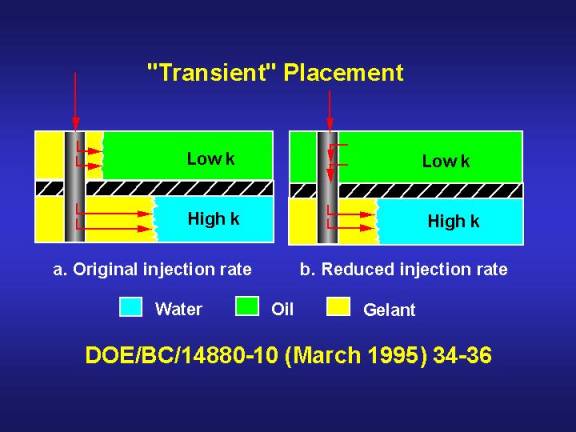Can Pressure-Transient Effects Be Exploited to Minimize Gelant Penetration into Low-Permeability Zones?
(Yes, under limited circumstances, and only if intra-wellbore crossflow is confirmed to occur for a sufficiently long period of time.)
Breston58 speculated that selective placement can be achieved by a sudden reduction in injection pressure when the plugging agents reached the target zones (calculated from pipe dimensions and the injection rate). Conceptually, a sudden decrease in injection pressure would create a transient period during which fluids in the reservoir could flow back into the well (Fig. 21). The length of the transient period is inversely proportional to the formation permeability.59Breston's idea relies on the difference in transient times between the high- and low-permeability zones to achieve selective placement. The author asserted that due to the shorter transient time, enough plugging agents can be placed into high-permeability zones while the less-permeable zones are still backflowing. However, supporting evidence was not provided.

The feasibility of this idea depends on whether the difference in transient times is long enough to allow a realistic amount of the plugging agent to be placed into the high-permeability zone. Consider a reservoir with a 1,500-md high-permeability zone and a 10-md low-permeability zone. In this example, the injection pressure at the wellbore is suddenly reduced from pwo to pw2 where (pwo-pe)=2(pw2e). We assume a steady-state flow condition in the reservoir before the injection pressure reduction. The parameters in this example are listed in Table 3. Before the injection-pressure reduction, the radial distance into the reservoir, r2, where the pressure is equal to pw2 can be determined by13

In this example, r2 is (372x0.3).5= 10.5 ft. This indicates that before the injection-pressure reduction, reservoir pressure within a 10.5 ft radius from the well is greater than pw2. A sudden reduction in injection pressure from pwo to pw2 creates a pressure pulse that travels outward into the reservoir. The pressure in the reservoir would remain greater than the wellbore pressure, pw2, until the pressure pulse reaches r2. In order for the reservoir fluid to backflow into the well, reservoir pressure must be greater than the wellbore pressure. The transient time is therefore the time required for the pressure pulse to reach r2. In pressure-drawdown analysis, the transient time is defined as

where f is porosity, µ is fluid viscosity in cp, c is compressibility in psi-1, re is drainage radius in ft, and k is formation permeability in md.59 This equation calculates the time required for the pressure pulse to reach the drainage radius. The time required for the pressure pulse to reach r2 can be estimated by substituting re for r2 in the equation. In our example, the transient time for the high-permeability zone (k1=1,500 md) is about 0.05 seconds and the transient time for the low-permeability zone (ki=10 md) is only about 7 seconds. Breston's concept relies on the difference in transient times between the high- and low-permeability zones to achieve selective placement. Our example demonstrates that the difference in transient times (7-0.05=6.95 sec.) is obviously too short for this concept to have any practical value.
| k1=1,500 md | ki=10 md |
| f=0.21 | m=0.7 cp |
| c=3x10-6psi-1 | rw=0.3 ft |
| re=372 ft (20 acre, 5 spot pattern) |
One other possible way of achieving selective plugging is to exploit the difference in formation pressures between high- and low-permeability zones. This is possible only when the zones are separated by an impermeable barrier and when the formation pressure in the low-permeability zone is significantly higher than that in the high-permeability zone. Selective placement could be achieved by injecting the plugging agent at an injection pressure which is high enough to place a significant amount of plugging agent into the high-permeability zone in a reasonable period of time and yet low enough not to exceed the formation pressure in the low-permeability zone.13
The most effective method to establish whether or not the transient-placement concept is of value in a particular well is to (1) place a profiling tool in the well, (2) make a step change in injection or production rate to the desired value, and (3) measure how long the transient period lasts. If this procedure is not performed to satisfactorily demonstrate that the transient period lasts long enough, the transient-placement concept should not be used.13